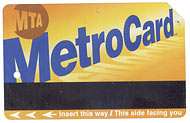Tom McNamara, Blueprint America
 Two-thirds of all mass transit riders in the United States use the Metropolitan Transportation Authority (MTA) of New York’s system. The MTA board voted Wednesday, The New York Times reported, “to enact a series of fare hikes and service cutbacks needed to keep the transit system from going broke.”
Two-thirds of all mass transit riders in the United States use the Metropolitan Transportation Authority (MTA) of New York’s system. The MTA board voted Wednesday, The New York Times reported, “to enact a series of fare hikes and service cutbacks needed to keep the transit system from going broke.”
About 1,100 of the authority’s 70,000 employees will be laid off. Fares for commuter rail, subway and bus transit will increase at least 20 percent across the board. Service cuts include the elimination of 35 bus routes and two subway lines, the W and Z. Off-peak and weekend subway, bus and commuter rail service will be cut back. Existing tolls on bridges will also rise.
Still, the MTA had hoped to avoid the draconian measures.
The vote came as legislators at the state capitol in New York have so far failed to act on a plan developed by a panel headed by the MTA’s former chairman, Richard Ravitch, imposing tolls on free East River and Harlem River bridges and creating a new corporate payroll tax to fill the budget gap.
| Metropolitan Transportation Authority Budget Problems
Ridership 2007: 2.3 billion (bus and subway) |
After weeks of debate and deliberation, The New York Times reported, “several Democratic senators from Brooklyn, Queens and the Bronx remain adamantly opposed to the tolls. And with Democrats holding a bare 32-30 majority in the Senate, and Republicans refusing to provide any votes for the plan, the Senate majority leader, Malcolm A. Smith, has been forced to come up with an alternative plan that could win enough support to pass in his chamber…”
That plan, though, comes up too short in adequately addressing the MTA’s budget needs – a deficit of $1.2 billion in operating costs alone. It includes a 4 percent fare increase, half of what Ravitch had proposed, and would impose a tax of 25 cents on every $100 of payroll on employers within the 12 counties served by the authority, significantly less than the 34 cents that Ravitch had proposed.
As a result, with no sufficient alternatives offered by the state legislature – and with no new tolling on drivers – the MTA voted to burden local transit users (who already cover the highest proportion of transit operating expenses in the country) to keep the system from bankruptcy.
A look at the subway fare increase
|
Fare Type |
Current |
After Increase |
|||
| Base Pay-Per-Ride MetroCard Fare |
$2
|
$2.50
|
|||
| Cash/Single-Ride Ticket |
$2
|
$2.50
|
|||
| Pay-Per-Ride Bonus and Minimum Purchase Threshold |
15% with $7 or more purchase
|
15% with $7 or more purchase
|
|||
| Effective Pay-Per-Ride Fare with Bonus |
$1.74
|
$2.17
|
|||
| Unlimited Ride MetroCard | |||||
| 1-Day |
$7.50
|
$9.50
|
|||
| 7-Day |
$25
|
$31
|
|||
| 14-Day |
$47
|
$59
|
|||
| 30-Day |
$81
|
$103
|
Source: Metropolitan Transportation Authority (MTA) of New York


